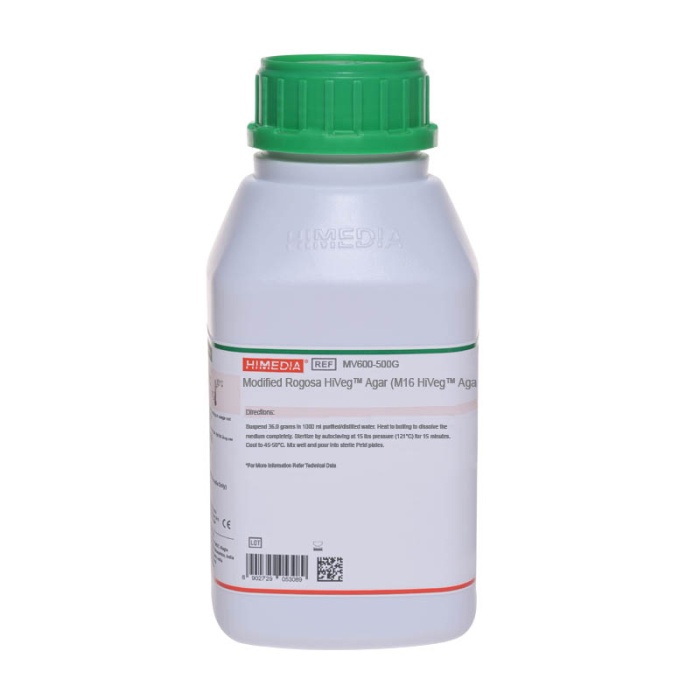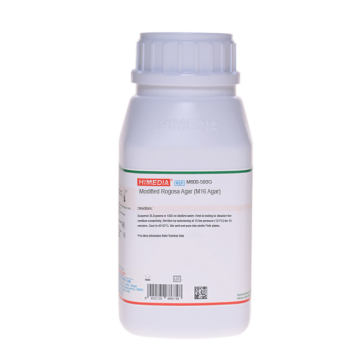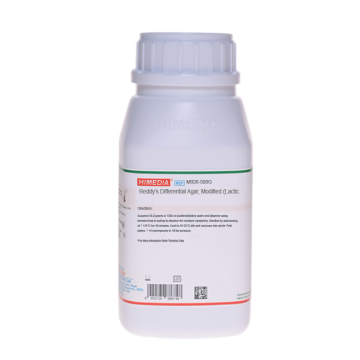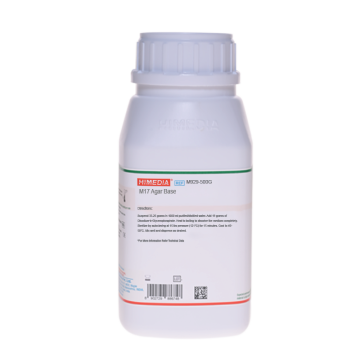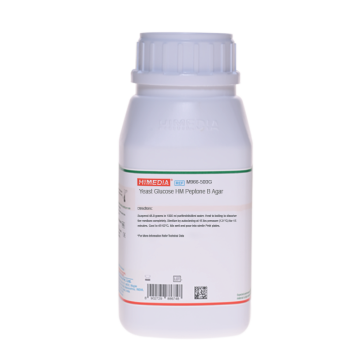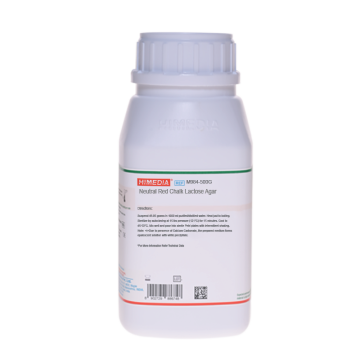 Your enquiry has been submitted
Your enquiry has been submitted
M17 Agar w/ Glycerophosphate
Intended Use
Recommended for cultivation of lactic Streptococci and plaque assay of lactic bacteriophages
Composition**
| Ingredients | Gms / Litre |
|---|---|
| Soya peptone | 5.000 |
| Biopeptone | 5.000 |
| Yeast extract | 2.500 |
| HM peptone B # | 5.000 |
| Lactose | 5.000 |
| Ascorbic acid | 0.500 |
| Magnesium sulphate | 0.250 |
| Disodium-ß-glycerophosphate | 19.000 |
| Agar | 10.000 |
Final pH (at 25°C): 7.1±0.2
**Formula adjusted, standardized to suit performance parameters
# - Equivalent to Beef extract
Directions
Suspend 52.25 grams in 1000 ml purified/distilled water. Heat to boiling to dissolve the medium completely. Sterilize by autoclaving at 15 lbs pressure (121°C) for 15 minutes. Cool to 45-50°C. Mix well and pour into sterile Petri plates.
Principle And Interpretation
M17 media are based on the formulation described by Terzaghi and Sandine (9) for the cultivation and enumeration of lactic Streptococci and their bacteriophages. It is possible to study plaque morphology and lysogeny. M17 Agar is recommended by the International Dairy Federation (3) for selective enumeration of Streptococcus thermophilus from yoghurt. M17 Agar is recommended by APHA for the cultivation of lactic Streptococci (7).
Shankar and Davies (8) reported isolation and enumeration of Streptococcus thermophilus from yoghurt. It is also suitable for cultivation and maintenance of starter cultures for cheese and yoghurt manufacturing. This medium helps in detecting streptococcal mutants that are lactose non-fermenters.
Lactic Streptococci are nutritionally fastidious and require complex media for optimal growth (2,6). Disodium glycerophosphate maintains the pH above 5.7. The maintenance of pH is very important as lower pH results in injury and reduced recovery of lactic Streptococci. Glycerophosphate does not form precipitate with calcium which is needed for the plaque assay of lactic bacteriophages.
Soya peptone, yeast extract, HM peptone B and biopeptone provide carbonaceous, nitrogenous compounds, vitamin B complex and other essential growth factors. Lactose is the fermentable carbohydrate and ascorbic acid is stimulatory for the growth of lactic Streptococci. Magnesium sulphate provides essential ions to the organisms. Disodium-ß-glycerophosphate maintains the pH above 5.7. The maintenance of pH is very important as lower pH results in injury and reduced recovery of lactic Streptococci. Disodium glycerophosphate suppresses Lactobacillus bulgaricus.
Type of specimen
Dairy samples
Specimen Collection and Handling: (1)
Suggested technique to enumerate streptococci is to seed in mass or by stabbing with agar, melted and cooled to 50-55°C, and incubating them at 42°C for 24 hours period. With these conditions, all the colonies might be streptococci. Longer incubation periods or lower temperatures may cause morphological changes in the colonies, which hinders in the recognition of the colonies. Lactose-positive colonies of streptococci are visible after 15 hours and after 5 days they may reach a diameter of about 3-4 mm, whereas those of lactose-negative are 1 mm in diameter. Bacteriophages presence is observed by appearance of characteristic plaques over the bacterial growth. After use, contaminated materials must be sterilized by autoclaving before discarding.
Warning and Precautions :
Read the label before opening the container. Wear protective gloves/protective clothing/eye protection/face protection. Follow good microbiological lab practices while handling specimens and culture. Standard precautions as per established guidelines should be followed while handling specimens. Safety guidelines may be referred in individual safety data sheets.
Limitations
- The maintenance of pH is very important as lower pH results in injury and reduced recovery of lactic Streptococci.
Performance and Evaluation
Performance of the medium is expected when used as per the direction on the label within the expiry period when stored at recommended temperature.
Quality Control
Appearance: Cream to yellow homogeneous free flowing powder
Gelling: Firm, comparable with 1.0% Agar gel.
Colour and Clarity of prepared medium: Light yellow coloured slightly opalescent gel forms in Petri plates
Reaction: Reaction of 5.23% w/v aqueous solution at 25°C. pH: 7.1±0.2
pH: 6.90-7.30
Cultural Response: Cultural characteristics observed after an incubation at 35-37°C for 24-48 hours.
| Organism | Inoculum (CFU) | Growth | Recovery |
|---|---|---|---|
| Enterococcus faecalis ATCC 29212 (00087*) | 50-100 | good-luxuriant | >=50% |
| Lactobacillus bulgaricus ATCC 11842 | 50-100 | none-poor | <=10% |
| Lactobacillus leichmannii ATCC 4797 | 50-100 | good-luxuriant | >=50% |
| Lactobacillus plantarum ATCC 8014 | 50-100 | good-luxuriant | >=50% |
| Streptococcus thermophilus ATCC 14485 | 50-100 | good-luxuriant | >=50% |
Key: *Corresponding WDCM numbers.
Storage and Shelf Life
Store between 10-30°C in a tightly closed container and the prepared medium at 20-30°C. Use before expiry date on the label. On opening, product should be properly stored dry, after tightly capping the bottle in order to prevent lump formation due to the hygroscopic nature of the product. Improper storage of the product may lead to lump formation. Store in dry ventilated area protected from extremes of temperature and sources of ignition. Seal the container tightly after use. Product performance is best if used within stated expiry period.
Disposal
User must ensure safe disposal by autoclaving and/or incineration of used or unusable preparations of this product. Follow established laboratory procedures in disposing of infectious materials and material that comes into contact with sample must be decontaminated and disposed of in accordance with current laboratory techniques (4,5).
Reference
- American Public Health Association, Standard Methods for the Examination of Dairy Products, 1978, 14th Ed., Washington D.C.
- Anderson A.W. and Elliker P.R., 1953, J. Dairy Sci., 36:161.
- International Dairy Federation, 1981, Joint IDF/ISO/AOAC Group E44.
- Isenberg, H.D. Clinical Microbiology Procedures Handbook 2nd Edition.
- Jorgensen, J.H., Pfaller, M.A., Carroll, K.C., Funke, G., Landry, M.L., Richter, S.S and Warnock., D.W. (2015) Manual of Clinical Microbiology, 11th Edition. Vol. 1.
- Reiter B. and Oran J.D., 1962, J. Dairy Res., 29:63.
- Salfinger Y., and Tortorello M.L., 2015, Compendium of Methods for the Microbiological Examination of Foods, 5th Ed., American Public Health Association, Washington, D.C.
- Shankar P.A. and Davies F.L., 1977, Soc. Dairy Technol., 30:28.
- Terzaghi B.E. and Sandine W.E., 1975, Appl. Microbiol., 29:807.
- Wehr H. M. and Frank J. H., 2004, Standard Methods for the Microbiological Examination of Dairy Products, 17th Ed.,APHA Inc., Washington, D.C.
| Product Name | M17 Agar w/ Glycerophosphate |
|---|---|
| SKU | M1063 |
| Product Type | Regular |
| Physical Form | Powder |
| Origin | Animal |
| Packaging type | HDPE |
| References | 1. Terzaghi B.E. and Sandine W.E., 1975, Appl. Microbiol., 29:807. |
| Customized Product Available | No |





